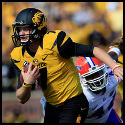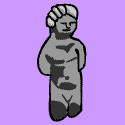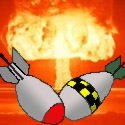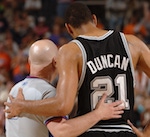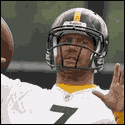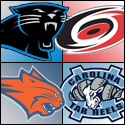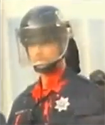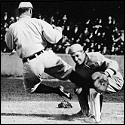|
I usually just focus on whatever team I'm rooting for. Where on that team I look usually changes depending on what I want to happen (or not happen). I get very frustrated watching football on TV and not being able to see what is going on downfield. The quarterback is just standing there, you're yelling at him to throw it, but you have absolutely no idea if anybody is open.
|
|
|
|

|
| # ? May 14, 2024 00:01 |
|
This is why I love watching option offenses; all the decisions are right there on camera where you can see them.
|
|
|
|
Crap, wrong thread.
consensual poster fucked around with this message at 04:30 on Nov 14, 2010 |
|
|
|
I watch the offensive line, because I get hard-ons for watching blocking schemes fold out, and I don't know how to read defenses yet. Speaking of, does anyone have like, a graphic representation of who has what zone in Cover 2,3,4,6, etc?
|
|
|
|
Not graphical, but the shells are fairly easy to understand: http://en.wikipedia.org/wiki/Football_coverage_shells The only confusing one is 6 since all the others are just referring to how many players have deep zone responsibility. e: 6 is basically a cover 3, except instead of everyone having a third of the field the coverage is rolled to one side, so two players have 1/4 of the field and the third guy is responsible for the other half of the field. Grittybeard fucked around with this message at 16:56 on Nov 14, 2010 |
|
|
|
Evoq posted:
Crosspostin from Open Letters. Someone care to explain how the divisional standings are supposed to work? I thought it was like regular W/L standings. How are the Chargers a game out of first place in the AFCW, at 1-2, when the Raiders are 3-0?
|
|
|
|
Evoq posted:
The divisional standings are based on regular win/loss record, and divisional win/loss only comes into play as a tie breaker. So the Chargers at 4-5 are 1 game behind the 5-4 Raiders and Chiefs in the division. The Raiders are currently in first over KC because while they're tied in regular w/l, Oakland is 3-0 in the division while KC is only 1-2. e: Right, forgot that head to head tie break comes before divisional record. Crowbear fucked around with this message at 16:49 on Nov 15, 2010 |
|
|
|
Evoq posted:
Division standings don't kick in unless there is a tie with the overall standings. So the 5-4 Raiders and the 5-4 Chiefs are winning the Division with the 4-5 Chargers one game behind them. If they end up with a tied record at the end of the year they go to Head to head, so if one team won two games against the other then they would win the division. If they split the head to head then they go to Divisional record. For example in the NFC North right now. The Bears and Pack are tied at 6-3, However if the season ended right now the Bears would win the Division as they beat the Packers in the one game they have played. thus winning the tiebreaker. Edit: Crowbear posted:The divisional standings are based on regular win/loss record, and divisional win/loss only comes into play as a tie breaker. So the Chargers at 4-5 are 1 game behind the 5-4 Raiders in the division. Hmm. I thought Head to Head came before Divisional record?
|
|
|
|
Dexo posted:
Yeah I'm pretty sure you're right, I just forgot about it. Tie-break rules are pretty fun, and can get reaaaallllly wacky when there's stuff like 3-way ties. Crowbear fucked around with this message at 16:54 on Nov 15, 2010 |
|
|
|
Ohhhhhh okay, that makes sense, thanks guys.
|
|
|
|
Evoq posted:Ohhhhhh okay, that makes sense, thanks guys. Your way works in college football so there's that at least
|
|
|
|
Here are the exact NFL rules for tiebreakers: TO BREAK A TIE WITHIN A DIVISION If, at the end of the regular season, two or more clubs in the same division finish with identical won-lost-tied percentages, the following steps will be taken until a champion is determined. Two Clubs 1. Head-to-head (best won-lost-tied percentage in games between the clubs). 2. Best won-lost-tied percentage in games played within the division. 3. Best won-lost-tied percentage in common games. 4. Best won-lost-tied percentage in games played within the conference. 5. Strength of victory. 6. Strength of schedule. 7. Best combined ranking among conference teams in points scored and points allowed. 8. Best combined ranking among all teams in points scored and points allowed. 9. Best net points in common games. 10. Best net points in all games. 11. Best net touchdowns in all games. 12. Coin toss Three or More Clubs (Note: If two clubs remain tied after third or other clubs are eliminated during any step, tie breaker reverts to step 1 of the two-club format). 1. Head-to-head (best won-lost-tied percentage in games among the clubs). 2. Best won-lost-tied percentage in games played within the division. 3. Best won-lost-tied percentage in common games. 4. Best won-lost-tied percentage in games played within the conference. 5. Strength of victory. 6. Strength of schedule. 7. Best combined ranking among conference teams in points scored and points allowed. 8. Best combined ranking among all teams in points scored and points allowed. 9. Best net points in common games. 10. Best net points in all games. 11. Best net touchdowns in all games. 12. Coin toss ================== And for the Wildcard: TO BREAK A TIE FOR THE WILD-CARD TEAM If it is necessary to break ties to determine the two Wild-Card clubs from each conference, the following steps will be taken. 1. If the tied clubs are from the same division, apply division tie breaker. 2. If the tied clubs are from different divisions, apply the following steps. Two Clubs 1. Head-to-head, if applicable. 2. Best won-lost-tied percentage in games played within the conference. 3. Best won-lost-tied percentage in common games, minimum of four. 4. Strength of victory. 5. Strength of schedule. 6. Best combined ranking among conference teams in points scored and points allowed. 7. Best combined ranking among all teams in points scored and points allowed. 8. Best net points in conference games. 9. Best net points in all games. 10. Best net touchdowns in all games. 11. Coin toss. Three or More Clubs (Note: If two clubs remain tied after third or other clubs are eliminated, tie breaker reverts to step 1 of applicable two-club format.) 1. Apply division tie breaker to eliminate all but the highest ranked club in each division prior to proceeding to step 2. The original seeding within a division upon application of the division tie breaker remains the same for all subsequent applications of the procedure that are necessary to identify the two Wild-Card participants. 2. Head-to-head sweep. (Applicable only if one club has defeated each of the others or if one club has lost to each of the others.) 3. Best won-lost-tied percentage in games played within the conference. 4. Best won-lost-tied percentage in common games, minimum of four. 5. Strength of victory. 6. Strength of schedule. 7. Best combined ranking among conference teams in points scored and points allowed. 8. Best combined ranking among all teams in points scored and points allowed. 9. Best net points in conference games. 10. Best net points in all games. 11. Best net touchdowns in all games. 12. Coin toss When the first Wild-Card team has been identified, the procedure is repeated to name the second Wild-Card, i.e., eliminate all but the highest-ranked club in each division prior to proceeding to step 2. In situations where three or more teams from the same division are involved in the procedure, the original seeding of the teams remains the same for subsequent applications of the tie breaker if the top-ranked team in that division qualifies for a Wild-Card berth.
|
|
|
|
SteelAngel2000 posted:Your way works in college football so there's that at least And it makes sense in college football because the talent contrasts are so stark. Let's say that West Virginia went 6-1 in Big East play but Cincinnati went 5-2. Cincinnati finished 10-2 because their non-conference schedule was something like Miami Ohio, McNeese State, Louisiana-Lafayette, Troy, and ECU, whereas West Virginia goes 9-3 because they scheduled Florida State and Oklahoma for non-conference games and lost both of them. Even though West Virginia's record is worse, they did better in conference play so they win the conference, so that Cincinnati isn't rewarded for playing worse teams.
|
|
|
|
For those who really want to get into the nitty-gritty of football, scheme/preparation-wise, you should look at https://www.coachhuey.comquote:"Run to the Numbers": Option Series out of 3x1 really, really exceptional resource
|
|
|
|
So I thought that when a player on the field lost his helmet the play was blown dead, but that didn't happen in the Packers/Vikings game. Does this rule only apply to the ballcarrier?
|
|
|
|
Xeras posted:So I thought that when a player on the field lost his helmet the play was blown dead, but that didn't happen in the Packers/Vikings game. Does this rule only apply to the ballcarrier? You are correct.
|
|
|
|
I noticed this in the Northwestern-Illinois game yesterday, but I think I've seen it elsewhere in college football, too. When they line up for the extra point, they line up all spread out and then audible to a normal field goal formation. Why do they do this? Are they just trying to catch the other team off guard any way they can? It seems weird that they would do that every single extra point.
|
|
|
|
loosenukes posted:I noticed this in the Northwestern-Illinois game yesterday, but I think I've seen it elsewhere in college football, too. When they line up for the extra point, they line up all spread out and then audible to a normal field goal formation. Why do they do this? Are they just trying to catch the other team off guard any way they can? It seems weird that they would do that every single extra point. I think it's because kickers prefer to line up their kick without the offensive line directly in front of them. Once they run through it in their head and step off to the starting point, the line moves into place. Kicking is 99% psychological, so whatever helps them focus, I guess.
|
|
|
|
I know when I played in HS there were teams who would default to a "swinging fence" formation as my coaches called it. The napper, kicker, and holder were in their normal position, but the line and everyone else were close to the sideline. The thought was they were trying to catch defenses off guard and pitch the ball over for an easy 2 point conversion. When we lined up in a defense to counter that they would line up for a normal pat. This is what I would think it would be, but with the amount of time and prep that goes into big time college ball that it would be a lot harder to catch people off guard and for it to work, but what do I know.
|
|
|
|
That's indeed called the "muddle huddle," "swinging gate," or "swinging fence." In theory depending on which way the defense lines up, you can run different fakes to different places, usually if someone is uncovered. Of course, the defense knows you run the muddle huddle from tapes, so they normally position their players reasonably and don't leave people uncovered. The typical set of muddle huddle fakes are a pass to one of the guys lined up on the opposite side from the linemen, a kicker draw up the middle, or a lateral to a wing lined up behind the offensive linemen. There are more creative versions. It's common at the high school level and used to be common at the college level, but has fallen out of favor over the last 5-10 years. I've always found the fakes turn into debacles unless they're practiced a fairly large amount since you need to install at least two to have a successful muddle huddle, and the plays are normally complex and involve precise timing. Most teams just aren't going devote a practice period per day to running muddle huddle fakes, and realistically given the success rates on both you'd probably be better off using that practice period to hone your fake punts instead. You also get the occasional illegal shift, delay, or false start that wouldn't occur if you lined up normally. Incidentally, most kickers that I've dealt with hate the thing because it screws up their regular routine. eta: The best variation involves the short snapper being an eligible receiver, although I want to say the NCAA kiboshed that a few years ago. I once saw a team run an Urban Meyer-style double sprint option out of the muddle huddle with the snapper, holder, and kicker, which was quite a fun play although a resounding disaster. oldfan fucked around with this message at 07:36 on Nov 22, 2010 |
|
|
|
Thanks, guys. I figured it was something along those lines.
|
|
|
|
jeffersonlives posted:I've always found the fakes turn into debacles unless they're practiced a fairly large amount since you need to install at least two to have a successful muddle huddle, and the plays are normally complex and involve precise timing. Most teams just aren't going devote a practice period per day to running muddle huddle fakes, and realistically given the success rates on both you'd probably be better off using that practice period to hone your fake punts instead. You also get the occasional illegal shift, delay, or false start that wouldn't occur if you lined up normally. The muddle huddle (or formation shifts in general) are great if you know you're playing against a team with d-lineman who are undisciplined and have problems reacting only to the snap. I've seen muddle huddles result in 1st downs way more than a successful 2-point conversion.
|
|
|
|
Speaking of fakes turning into debacles and swinging gates, here's an example from last year. http://www.youtube.com/watch?v=UdX1rdLcTk8
|
|
|
|
Mr. Despair posted:Speaking of fakes turning into debacles and swinging gates, here's an example from last year. I'll bet it's been talked about to death, but honestly what were they trying to do there?
|
|
|
|
C-Euro posted:I'll bet it's been talked about to death, but honestly what were they trying to do there? The play design is a screen left to either the kicker in motion or the left wing - and they actually had an 8-on-5 out there for that - but the holder freaked out when he saw the pass rush and just launched it. That destroys your numbers advantage because of the 8, most are ineligible receivers, of course.
|
|
|
|
jeffersonlives posted:The play design is a screen left to either the kicker in motion or the left wing - and they actually had an 8-on-5 out there for that - but the holder freaked out when he saw the pass rush and just launched it. That destroys your numbers advantage because of the 8, most are ineligible receivers, of course. I also believe they lined up for that, there was a penalty, and then they tried it again. It has lost all it's surprise element.
|
|
|
|
Bashez posted:I also believe they lined up for that, there was a penalty, and then they tried it again. It has lost all it's surprise element. It's also about a 5-10 yard play design and they tried it at the end of the half from a lot longer than that, so the most interesting question is why they ran that in that situation.
|
|
|
|
Random question. I was at a resteraunt working on a paper last night and my teams Left Tackle was talking with some NFL agent at the table next to me. At what point are players allowed to talk to agents? Are they permitted to talk to them any time after they get to college and just arent allowed to take money/gifts? Or are they not supposed to talk to them at all until after the season is over? At first thought it was pretty cool that he was there with agents and stuff, and then I couldnt remember what the rules about that were so maybe it wasnt so cool.
|
|
|
|
If they're just talking it's fine (even according to the NCAA). The big no-no's are signing an agreement to be represented by the agent, taking benefits (in whatever form) from the agent or the agent's "runner's", or having the agent schedule workouts or gauge interest from a pro team. The cynic in most of us think the interest thing at least (let alone all the other violations that could come to pass) happens all the time, although ostensibly what you saw was on the up and up. From an NCAA page: http://www.ncaa.org/wps/wcm/connect/public/NCAA/Resources/Latest+News/2010+news+stories/July+latest+news/Guidelines+for+agents
|
|
|
|
Grittybeard posted:If they're just talking it's fine (even according to the NCAA). Yeah, after I thought about this for a bit I realized that I already knew that as long as they werent receiving benefits, players were allowed to talk to agents. Thanks for that link that, thats pretty cool and helpful.
|
|
|
|
Somebody explain how the "lining up" stuff works? I know you have to have 7 men on the line of scrimmage, but I've heard stuff like "the tackle is uncovered" and I'm not exactly sure what the deal there is.
|
|
|
|
5 of the 7 on the line of scrimmage are the O-line, and neither tackle can be uncovered IIRC. That means that there has to be a receiver (either a tight end or wide receiver) on the LOS between the tackle and the sideline. Legal: --W------TCGCTE----- W----------QB------W Illegal: --------TCGCTE---W- W---------QB------W because the LT is uncovered on the line of scrimmage. I don't know why it's a rule, just that it is one. Also, tackles have to have their head between the shoulder pads and butt of the center, or else it's a penalty. It rarely gets called, though, unless your o-line is lovely (like Pittsburgh). e: vvvv yeah, that's it. Blackula69 fucked around with this message at 20:35 on Dec 6, 2010 |
|
|
|
Blackula69 posted:5 of the 7 on the line of scrimmage are the O-line, and neither tackle can be uncovered IIRC. That means that there has to be a receiver (either a tight end or wide receiver) on the LOS between the tackle and the sideline. An uncovered tackle is technically an end, and therefore an eligible receiver. However, since he's wearing a lineman's number the player must inform the referee before the play that's he's an eligible receiver. Tackle-eligible plays turn up every now and then. Any formation with 7 guys on the line and 4 in the backfield is legal as far as I know. When you see multiple WR sets, usually one or two will be back from the line a bit, putting them in the backfield.
|
|
|
|
Deteriorata posted:An uncovered tackle is technically an end, and therefore an eligible receiver. However, since he's wearing a lineman's number the player must inform the referee before the play that's he's an eligible receiver. Tackle-eligible plays turn up every now and then. This is mostly right. In college an offensive lineman can never be an eligible receiver because his number must be between 50-79 and those numbers are never allowed to be eligible receivers. In the NFL an O-lineman can inform the ref that he's an eligible receiver, but he must do so every time since his eligibility lasts for only one play.
|
|
|
|
crm posted:Somebody explain how the "lining up" stuff works? I know you have to have 7 men on the line of scrimmage, but I've heard stuff like "the tackle is uncovered" and I'm not exactly sure what the deal there is. I don't think you got a very good definition so here's my crack at it. Everyone in the backfield is an eligible receiver. The outermost players, on the LOS, on both sides are also eligible receivers. The outermost player on the line of scrimmage (for each side) is covering the guys inside of him, making them ineligible. For instance, you have a tight end and a wide receiver on the right hand side. 1) The receiver and TE are off the line. The tackle is uncovered and eligible (and the formation is likely illegal because the TE probably needed to be on the line to make 7, I think the tackle needs to report even if he isn't running a route but I'm not positive). 2)The receiver is off the line and the TE is on the line. The TE is covering the tackle and both the TE and WR are eligible receivers, the tackle is not. 3) The receiver and TE are both on the line. The receiver is covering the TE and the TE is ineligible. The WR probably hosed up here. When you see receivers go out you often see them point at the zebra next to him (line judge?) and he's basically asking I'm off the line, you got that right? so he can make sure he isn't accidentally covering/uncovering someone when he shouldn't be.
|
|
|
|
DrGonzo90 posted:In the NFL an O-lineman can inform the ref that he's an eligible receiver, but he must do so every time since his eligibility lasts for only one play. I've seen this a few times, but how often does it actually work since it seems like it won't since the other team knows he's eligible. Goal line situations/short yardage?
|
|
|
|
Crunkjuice posted:I've seen this a few times, but how often does it actually work since it seems like it won't since the other team knows he's eligible. Goal line situations/short yardage? Usually it's in a goal line situation with the tackle lined up as a TE That's how you get Mike Vrabel, stud TE
|
|
|
|
You'll also occasionally see a defensive lineman or linebacker or even reserve offensive lineman at fullback or TE. Usually they're terrible at it, but there you go.
|
|
|
|
Some teams do it more than occasionally. The Jets use backup tackle Wayne Hunter as a tight end in much of the base offense, about 20 percent of snaps.
|
|
|
|

|
| # ? May 14, 2024 00:01 |
|
It's really annoying at games because they announce Hunter as an eligible receiver over the PA every single time he declares.
|
|
|






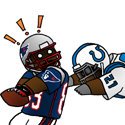




 . Is it only based on wins or something?
. Is it only based on wins or something?




